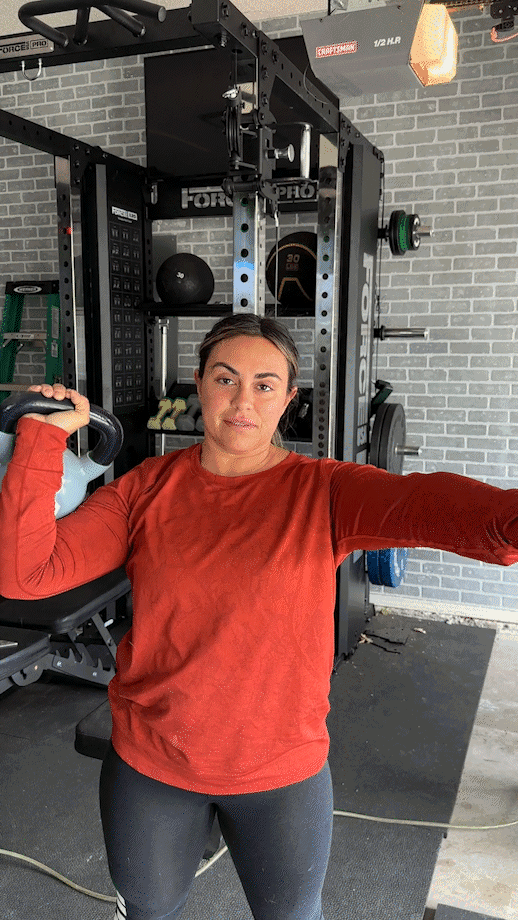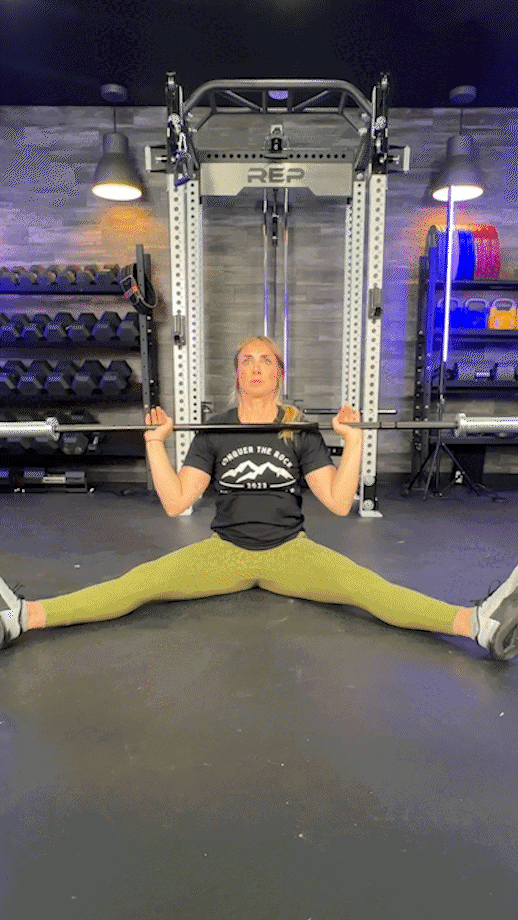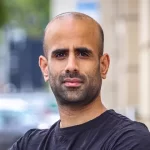When it comes to landmine exercises, landmine squats, landmine rows, and landmine presses are probably the three most popular. There are, of course, many more exercises, but lifters like myself love these three in particular. Today’s focus will be on the latter of these—the landmine press.
I’ll start by digging into my years of experience as a certified personal trainer to explain how to do the exercise with proper form, before talking about the benefits of doing the landmine press in the first place. After this, I’ll go through three common mistakes when adding this exercise to your training program.
So, whether you’ve never tried landmine training or are a seasoned veteran, read on to learn more.
How to Do the Landmine Press
Muscles worked: Chest, delts, triceps, core
- Add your preferred weight to the barbell. Stand at the end of it, facing the landmine attachment.
- Squat down to pick up the bar by interlocking the fingers in both hands, then stand up.
- Bring the bar to chest height and let go with your right hand so the bar is in your left hand.
- Brace your core, then press the bar up (and slightly forward) until your left arm is straight. You’ll want to lean into the bar as you do this.
- Hold for a moment. Now, slowly return the bar to the starting position.
- Repeat for the desired number of reps before switching to the other side.

Trainer Tips for Form
Let’s talk about form in more detail. Here are some CPT tips for you to get the most out of this exercise:
Brace Your Core
The single-arm landmine press uses the core to a great extent. A 2016 study by the European Journal of Applied Physiology1 showed that contracting the abdominal muscles can be an effective maneuver for increasing strength and power during movements involving the trunk. Bracing the core can also help reduce the risk of injury to the spine.
Push Up and Out
The bar path and position are important for this exercise. If you’re used to doing an overhead press, you may be tempted to lift the bar vertically. Alternatively, because it’s not quite an overhead press, you might opt to push the bar horizontally. The truth is—it needs to be a bit of both. Start light and get this movement before adding heavier loads.

Lean Into the Bar
At the top of the movement, when your arm is close to being straight, you’ll want to lean into the bar slightly. This helps you get a full range of motion and is better for stability. However, don’t lean too far forward because this is a landmine press and not a barbell shoulder press. Experiment with your range of motion and find what works for you.
Landmine Press Benefits
Why should you do the landmine press in the first place? The following are what I believe to be the top three benefits to giving this exercise a try:
Joint-Friendly Bar Path
The bar path on a landmine press is friendlier on the joints compared to overhead presses and dumbbell shoulder presses, helping with shoulder stability. When you press, you press at an angle rather than straight overhead. Therefore, the movement of the scapula is more natural with the landmine press, which is why many lifters prefer it.
Helps Fix Muscular Imbalances
Most common exercises for the chest and shoulders involve training bilaterally (both sides of the body at the same time). The landmine press is unique because it’s performed unilaterally. A 2016 review by the European Journal of Applied Physiology2 shows that during bilateral actions, one limb may be weaker than the other. The landmine press helps to address this.
RELATED: Unilateral Exercises

Helps with Other Lifts
Regularly doing landmine presses can help you get stronger at other lifts. You use your chest, shoulders, and core in many other exercises, but especially the bench press, dumbbell shoulder presses, lateral raises, chest flyes, push-ups, and more. This may be even truer if you’ve been avoiding pressing exercises because they’re painful for the joints.
RELATED: Chest, Shoulder, Triceps Workouts
Common Landmine Press Mistakes
It’s important to know common landmine press mistakes and how to avoid them to get the most out of your effort and prevent injury.
Arching Your Lower Back
When setting up for the landmine press, some lifters arch their lower back by leaning backward. This is unnecessary and puts strain on the lower back and spine. One of the benefits of doing the landmine press over the military press is that there’s no reason to arch your lower back. You’ll want to maintain a neutral position throughout the exercise.
Elbows Too Close
A common mistake I see with the landmine press is the elbows being too close to the body. You don’t want your elbows flaring out, but you don’t need your arms tucked in too closely, either. This becomes uncomfortable and makes pressing heavy loads difficult. Don’t overthink this, and do what feels natural.
Rolling Your Wrists
If your wrists roll backward, this could lead to injury. There are two main reasons why this could be happening. First, you may need to hold the bar tighter than you’re doing currently. Second, you’ll want to ensure that your thumb is at the end of the bar and the bar is in your lower palm. Both help to maintain a neutral wrist position.
RELATED: Wrist Mobility Exercises
Landmine Press Variations and Alternatives
Although the standing landmine press is described above, there are variations of the movement that are important to know. For example, you can do the exercise with a resistance band or while half-kneeling. Alternatively, you may not have a landmine base and want to replicate the movement with one of the best kettlebells instead.
After doing the landmine press, some people may want to try the overhead press or Z-press. Below are five variations and alternatives:
Banded Landmine Press
Why do it: The benefit of adding a resistance band to this pressing exercise is that it creates constant tension throughout the entire range of motion. You don’t need as much weight as you would with a regular landmine press (or any at all!), but you’ll still reap all the benefits.
How to do it:
- Loop one end of a resistance band around the end of the barbell (with the bar placed in the landmine base). Set the other end of the band underneath your right foot.
- Stand tall with your feet either next to each other or in a split stance.
- Place the bar in your left hand, then position it at chest height.
- Engage your core muscles, then press the bar to lock out. Pause here.
- Return the barbell to the original position in a controlled manner.
- Press for repetitions. Repeat with your right hand, changing the band so it’s underneath your left foot instead.
RELATED: Best Resistance Bands

Half-Kneeling Landmine Press
Why do it: One of the most popular landmine exercises there is, the half-kneeling landmine press is a progression from the regular landmine press because the bar path is more vertical and requires more core stability. You can’t use your lower body at all with this exercise.
How to do it:
- Load the barbell, then get into the half-kneeling position with your left leg forward and right leg behind. You’ll want to face the landmine attachment here.
- Lift the bar off the floor with both hands and position it near the chest region. Let go with your right hand so the bar is in your left hand.
- With your chest up and core tensed, press the bar upwards (and at a slight angle) until your left arm is extended.
- Pause, then lower the bar to where it came from.
- Keep going for reps. Repeat on the opposite side.

Single-Arm Kettlebell Press
Why do it: You’ll build muscle in your deltoids, rotator cuffs, triceps, and trapezius with the single-arm kettlebell press. It’s a great way to mimic a landmine press without needing a landmine attachment and an Olympic bar, making it an ideal choice for beginners.
How to do it:
- Grab a kettlebell with your left hand, then place it by your left shoulder while standing.
- Position your feet hip-width apart, and make sure you squeeze your glutes and brace your core.
- Press the kettlebell overhead until your left arm is straight. Hold, then return it to the original position with control.
- Continue for the desired number of repetitions. Then, do the same with the right hand.
RELATED: Best Kettlebell Exercises

Overhead Press
Why do it: The overhead press—aka the military press—is a strength training staple because it works the majority of the muscles in your upper body, including your shoulders (anterior, lateral, and posterior delts), upper chest, lats, triceps, and core.
How to do it:
- On a squat rack, adjust the J-hooks so the bar is at shoulder height. Then, add the necessary weight plates.
- Get underneath the bar, ensuring your feet are firmly planted on the floor. The bar should be resting on your upper chest and your palms facing the ceiling.
- Unrack the bar, then take a couple of steps backward.
- With a neutral head and spine position, push the bar upwards to lock out. You’ll need to move your head out of the way slightly for this.
- Pause, then slowly bring the bar back down to your upper chest.
- Keep pressing for reps.

Z-Press
Why do it: With the overhead press above, you’re able to use the legs if things get tough. (Technically, this is a push press exercise, not an overhead press). The Z-press means you can’t use your legs for momentum, helping to build strength in the shoulders and core.
How to do it:
- Sit on the floor in front of a squat rack with your legs wide apart and extended. You’ll want to ensure the barbell is at shoulder height and your body is upright.
- With an overhand grip, unrack the bar and bring it to your upper chest.
- Engage your core, then press the bar until your arms are extended.
- Hold for a moment, before lowering the bar to the starting position.
- Repeat for reps, re-racking the barbell when you’re done.

Useful Landmine Press Equipment and Accessories
You’re probably wondering, “What equipment and accessories will help with the landmine press?” Here are my top three:
A Landmine Base
Although you can replicate a landmine attachment by using a dumbbell and a weight plate, it’s easier to get a landmine attachment if you’re going to be doing exercises such as landmine presses, landmine lunges, and t-bar rows. The Titan Base Landmine is an example of a quality base, and it can be either secured to the floor or left unbolted and portable.
Quality Weight Plates
With your landmine workout, some exercises will require weight plates, and some won’t. From my experience, the landmine press quickly becomes too easy without the best weight plates. I could be here all day talking about the different types of plates and their benefits, but it’s worth doing some research to see what could work for you and your budget.

A Landmine Press Handle
Yes, a single-handle landmine press isn’t a necessity and I’ve described how to do the exercise without a handle above. However, every little bit helps. It’s easier to grab a handle than the end of the barbell, and using one may mean less strain on your wrists. You can also use the handle for a range of exercises too, making it extremely versatile.
Landmine Press: FAQs
What is the landmine press good for?
The landmine press is good for working the muscles in the chest, shoulders, upper back, triceps, and core. It’s usually done unilaterally (one arm at a time), so you can’t dominate with your stronger arm. Compared to the overhead press, many find the landmine press beneficial for their shoulder health because you push the bar at an angle rather than straight overhead.
RELATED: Upper Chest Workout
Does landmine press increase punching power?
If you’re looking to increase your punching power, the landmine press can be a great full-body exercise to include in your workout routine. You use and strengthen your core with the landmine press, which helps with punching power. It’s also an explosive exercise which can also be beneficial to increase the power in your punches.
RELATED: Explosive Workouts
What’s the difference between the landmine press and overhead press?
The main differences between landmine shoulder presses and overhead presses are the grip and bar path. With the former, you have a neutral grip and press the bar at an angle. With the latter, you have an overhand grip and press the bar directly upwards. As a result, those who have weaker shoulder joints generally prefer the landmine press.
Although you can do landmine presses with both hands, it’s usually done with one arm at a time. This is another difference between the two. Landmine presses can help fix muscular imbalances on either side of the body.
References
- Tayashiki K, Maeo S, Usui S, Miyamoto N, Kanehisa H. Effect of abdominal bracing training on strength and power of trunk and lower limb muscles. Eur J Appl Physiol. 2016 Sep;116(9):1703-13. doi: 10.1007/s00421-016-3424-9. Epub 2016 Jul 5. PMID: 27377782.
- Škarabot J, Cronin N, Strojnik V, Avela J. Bilateral deficit in maximal force production. Eur J Appl Physiol. 2016 Dec;116(11-12):2057-2084. doi: 10.1007/s00421-016-3458-z. Epub 2016 Aug 31. PMID: 27582260.






